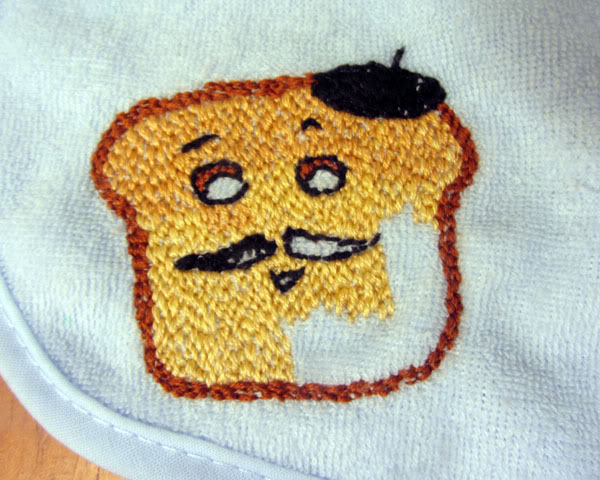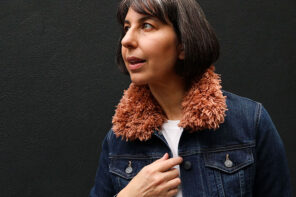
Today’s tute comes from Nellie
I love embroidery but haven’t ever posted an embroidery project, so when Nellie offered this cute French Toastie bib project, I couldn’t resist. So cute! She also includes some very clear diagrams to teach you the various stitches used.
Take it away Nellie…
One of my favourite friends is having her first baby in the next couple of months, (Maud, if your reading this – Spoiler Alert!!). I love her to bits, so I wanted to hand embroider her some baby bibs as a gift. Both the parents are French, but the newbie will be a little Aussie, so I thought one bib should have a picture of French toast and the other should have a toast triangle with Vegemite!

Today, I will show you how to transfer the French Toast template to fabric, then how to fill it in using Back Stitch, French Knots and Long and Short stitch. You can then apply a similar method to the Vegemite design.
You will need:
- 1 plain bib (prewashed)
- Dressmaker’s carbon paper (if your bib is a flat fabric) or tissue paper (if your fabric is fluffy like terry toweling)
- Embroidery hoop – optional
- Embroidery needle
- Embroider floss (DMC brand) in colours: 975 (warm brown), 310 (black), Blanc (white) and 437 (camel)
- Toastie Template
How to Embroider a Baby Bib
1. Download and print the Toastie Template. Check that the size of the French Toast design is right for your bib, if not, resize it using a photocopier.

2. Cut out the template and position it on the bib. If your bib is made from a flat material like cotton, transfer the design using dress maker’s carbon paper (just follow the manufacturers instructions). BUT if your bib is made from terry toweling (like mine), this method just won’t work! You’ll need to trace the template onto tissue paper then tack it to the bib around the design. If your tissue paper is a little thin, use two layers.
3. Optional – Put the bib into an embroidery hoop.

4. Following the stitch guide on the template, outline the design with Back Stitch (please scroll down for Back Stitch instructions) shorten your stitch as you go around curves. Please note: Embroidery floss is formed from six floss strands, you only need three for this project. Cut a length of floss, split it in two groups of three then load your needle with one of the groups.

5. If you’ve used it, peel off the tissue paper (using tweezers) and remove the tacking.

6. Again, following the template guide, fill in the remaining areas with Long and Short Stitch (please scroll down for Long and Short Stitch instructions).

7. Add two little French Knot pupils in the toasts eyeballs and some Back Stitch in two of the toast corners (please scroll down for French Knot instructions).
8. Neaten all loose threads at the back of the bib then…
9. Take a photo of your handy work for the archives!

Back Stitch Embroidery Instructions

Insert your needle a stitch length in front of your intended start point, then working back, re-insert the needle into the designs starting point. Continue inserting your needle a stitch length in front of the last then working it back into the previous stitch.
Long and Short Stitch Embroidery Instructions

Following the curve of your design, create a (close) row of alternating short and long length stitches (the ‘short’ stitch should be approx half of the ‘long’). For the following rows, use only one stitch length and start at the entry point of the stitch above (your stitches will appear long and short, but don’t be fooled!). Repeat until the area is full.
French Knot Embroidery Instructions

1. Insert the needle through the point you want the knot to be. Hold the thread taut with your (left) fingers approx 3cm (1.1″) from the entry point hold to the left.

2. Holding the needle above the work, wrap the taut thread over and under the needle twice.

3. Insert the needle into the entry point, continue to hold light tension whilst passing the needle through the material.




Thanks for this! From the first photo I thought it was machine embroidered, haha. Love it.